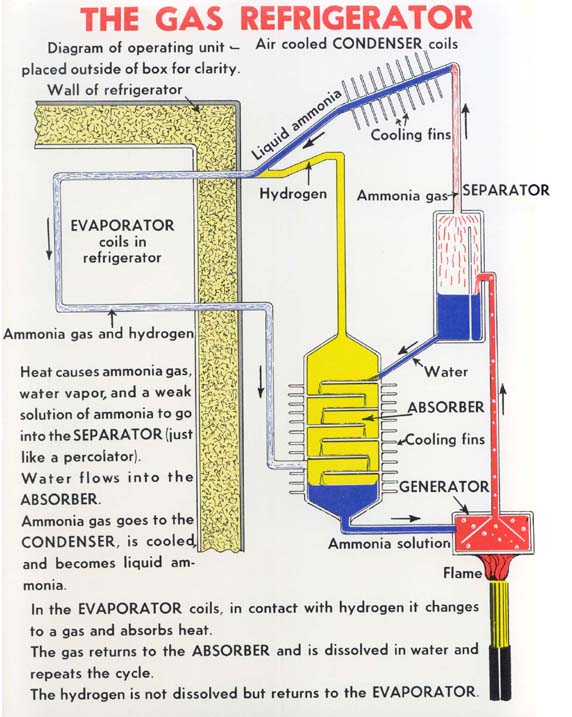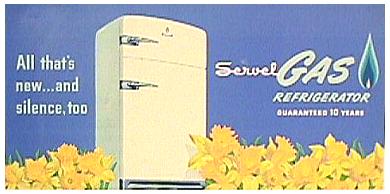| Our good old "Servel" refrigerator
came with the camp when we purchased it in 1972 and it has been a fine
refrigerator. We planned at the time to get a year or two out of it; but
with great service from fully licenced and experienced propane technicians,
it kept cold for the next 33 years!
However, during the summer of 2006, the old Servel behaved in a totally unsafe manner and we haven't used it since. I hope the details of this behaviour may help prevent a disaster for someone else. Old Servels have three flames:
After about forty-five minutes, unlit propane gas began flowing by itself even though the bimetal strip was cool! I heard the hissing sound, lit the flame, and the Servel cooled once again. However, when the refrigerator had cooled, all flames went out again. It was at this point that I turned the Servel off for good and we haven't used it since. It was not safe. The flame on our old Servel could go out and then start releasing unlit propane gas a half hour to an hour later. We could have burnt the camp down or perhaps blown it up if no one heard the gas. Someone could easily have died either from either a fire or from gas asphyxiation; but more than likely from a propane explosion when escaping gas reached the pilot lights on the stove. Update December 2009: Vintage Servel Refrigerators suggested the seal inside the "Klixon valve" may have failed. This is a very rare occurrence. 
Well, O.K., maybe it wouldn't have been this bad; but our old camp would have been a decidedly unhealthy place to be if the propane fumes had built up and reached the pilot lights on the propane stove. On the other hand, gas explosions can be very destructive . . . Now, this isn't supposed to happen. Servels are not supposed to release gas unless the bimetal strip is hot. This is supposed to make sure the gas flow stops if there is no flame. However, it most certainly did happen and I was right on hand to observe this behaviour and make notes which I still have and referred to while writing this page. I would urge anyone with an old Servel not to take any chances. Service it regularily and keep it in proper running condition; see Vintage Servel Refrigerators below for help. NOTE: We had the Servel serviced two months prior to this problem. It working perfectly in June, but finally gave up the ghost in August. If we owned an antique automobile from the 1940's, had it serviced and then headed off to Toronto, it would not be appropriate to blame the mechanic if something went wrong during the trip! The old Servel was a great refrigerator and it had expert service and maintenance. However, its life appears to be over - and fortunately, mine isn't! I hope the above story may help
prevent grief for others.

We have switched to a "Coleman Xtreme" cooler and don't intend to take a chance with propane refrigerators again. These coolers are available through Canadian Tire, Wall-Mart, Zellers and others. Strangely enough, my cousin Brian Sewell who has a camp near Williams Lake, B.C. had a similar experience during the summer of 2007 with an old Servel. Their problem related to a worn out burner and the production of unpleasant aldehyde gases. Brian and his family switched to a "Coleman Xtreme" cooler as well. New propane refrigerators are said to be "safe"; but ice is totally guaranteed not to release inflammable and potentially explosive gases! . . . Robert Sewell
|


